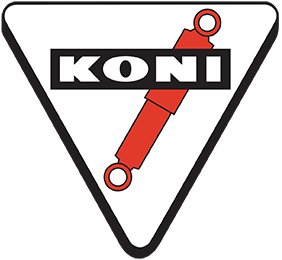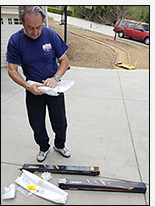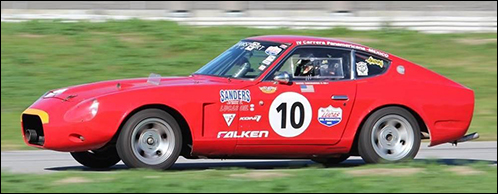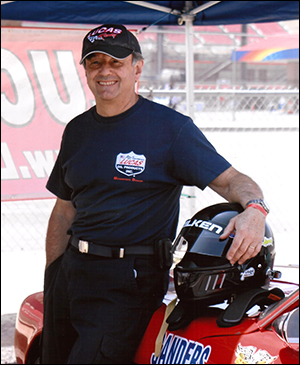Your shopping cart is currently empty. Need help finding the right part? Just contact us!
Hector Cademartori Tests & Reviews The New KONI Sport Yellow Struts!
 KONI was founded in 1857 in Oud-Beijerland, the Netherlands, by A. de Koning, thus the name of the company. Only after WW2 (for you millennials this means the Second World War) Koni started producing telescopic shock absorbers since originally they made leather equipment for horses. Go figure.
KONI was founded in 1857 in Oud-Beijerland, the Netherlands, by A. de Koning, thus the name of the company. Only after WW2 (for you millennials this means the Second World War) Koni started producing telescopic shock absorbers since originally they made leather equipment for horses. Go figure.  For us racing fans, the white triangle with the outline of a shock absorber and the black rectangle with the name was synonymous of racing shock absorbers. Even in the days before commercial sponsorships, racecars would display the white triangle. Motorsport Auto's Founder Greg Smith contacted me to help one of KONI's representatives to conduct a road test of their new shocks for classic Datsuns. At first, I thought we'd do it with my Datsun 240Z racecar, but later I found out that Gordon Benson, the engineer who came from their HQs in Kentucky to do the test, wanted a road car. Since my street 240Z was undergoing some engine work, I called my good friend and Group Z member Ian Stewart who offered one of his cars for the task. Motorsport Auto supplied four production prototypes which we installed at Ian's, which for those of you who have never been in his garage, it looks as if a nuclear device loaded with classic Datsun parts detonated inside. The car was ready for Gordon. I'm writing these lines right before leaving to the airport to go to Daytona for the Rolex 24 Hr. race. So stand by, don't go anywhere, because the story continues. I'll tell you about our little test, about the new KONIs and, if there's room, I'll add something about the race.
For us racing fans, the white triangle with the outline of a shock absorber and the black rectangle with the name was synonymous of racing shock absorbers. Even in the days before commercial sponsorships, racecars would display the white triangle. Motorsport Auto's Founder Greg Smith contacted me to help one of KONI's representatives to conduct a road test of their new shocks for classic Datsuns. At first, I thought we'd do it with my Datsun 240Z racecar, but later I found out that Gordon Benson, the engineer who came from their HQs in Kentucky to do the test, wanted a road car. Since my street 240Z was undergoing some engine work, I called my good friend and Group Z member Ian Stewart who offered one of his cars for the task. Motorsport Auto supplied four production prototypes which we installed at Ian's, which for those of you who have never been in his garage, it looks as if a nuclear device loaded with classic Datsun parts detonated inside. The car was ready for Gordon. I'm writing these lines right before leaving to the airport to go to Daytona for the Rolex 24 Hr. race. So stand by, don't go anywhere, because the story continues. I'll tell you about our little test, about the new KONIs and, if there's room, I'll add something about the race.Until then.
Hector Cademartori

February, 2019
Hello, everybody! I’m back from Daytona to resume this conversation about the new product that Motorsport Auto is adding to its already vast catalog. According to Mr. Smith (correct me if I’m wrong, Greg) Motorsport Auto not only will sell the KONIs, but is the global (as in planet earth global) distributor for the Datsun applications. Do I hear a “wow!”? DO I HEAR A “WOW”? Back to the test.We installed the shocks on Ian’s ’74 260Z…well, he did most of the work while I tightened a few nuts, talked about our next ChumpCar race and looked handsome in my Lucas Oil T-Shirt. Even though Greg offered to take the car to a shop we chose to do it ourselves to experience first-hand the procedure which was pretty much straight forward since we’ve done it many times.
After removing the old Tokico Illumina’s, the KONI’s went right in. Strut housing diameter is the same ‘70 through ’74 (’75 through ’78 is larger). We installed 160lb and 180lb springs front and rear respectively but we had to shorten the bump stops since our springs were shorter than the stock units. These springs also lower the car about 1.5 inches. I should mention that the car’s suspension had been freshened with urethane bushings and was fitted with 15x7 Panasport wheels wrapped in Toyo 225x45/15 tires.
We took a brief drive around Ian’s house to make sure that everything was nice and tight and the car was ready for our test drive. Gordon Benson, the designated engineer in charge of this project, came from Kentucky. Gordon is a young guy who started in our sport long after Datsuns disappeared from the scene and became Nissans but, as they say, he’s an “old soul”. “My Dad raced an Mk1 Sprite (Bugeye/Frogeye). He built the car in 1967 and raced it until he retired from the sport. I went to all the races with him over the years as we did it as a family. Mostly in the mid-west area”, he told us. Our kind of guy.
We started from my home in La Verne and headed towards my private testing grounds, aka Mount Baldy Road, which starts in nearby Claremont, It was a Wednesday morning so it was a perfect day for our purposes. We set the shocks in the softer setting. The twisty road with some irregularities along the way immediately told us that we needed a stiffer setting so we moved the knob at the top of the rod to the middle and that worked really well. We then set it to the hardest point and the car turned very difficult to drive, jumping right and left and, obviously a setting more suitable for a smooth race track than a public road, a feeling that was evident even at low speeds coming back on streets and avenues of Claremont and La Verne. Customers can play with fine tuning their shocks according to the springs and road conditions, but we all like to have a pleasant and soft drive in our everyday drives, and somewhere between soft and middle should be a good place to start.
The Tokico Illuminas had 5 positions marked with small numbers on a dial on top of the rod. The KONIs, on the other hand, have a knob that you can turn two turns up or down. I really like that because in case you lose your concentration you can easily go back to the beginning and start all over, not like some systems with 75 turns that you count and your wife yells from the other room, “Honey, is your Mom’s number 4076 or 5097?” and you instantly forgot if you were on turn 46 or 56.
During our day driving around we talked with Gordon a lot, including his VW Golf race car but, in brief, these are some of the questions pertinent to the KONIs:
HC: We all remember the KONI “reds” from decades ago, are these new ones similar to those?
Gordon: The valving is actually pretty close. The purpose of our test was to determine if I was close in real life to my calculations, and I believe we are. Obviously there are some small differences due to part changes over the years but I tried to keep them close to the original spec we had.
HC: What would be the main differences?
Gordon: Main difference is the external adjustment. We made some of these back in the 1980s with the external adjustment but they fell off the map sometime in the early 1990s.
HC: The adjustment affect the rebound only, right?
Gordon: Yes, rebound only. Compression and rebound have different functions so having rebound only is actually preferred. The short answer is that the compression handles the unsprung weight of the car, while the rebound handles the sprung weight.
HC: I remember that in the old ones you had to remove the shocks from the car to change the settings.
Gordon: Yes, the standard old KONIs we made for the Datsuns did have to be removed from the car to be adjusted. All of our dampers until the 1980’s were basically like that.
HC: And what about shocks for the other models?
Gordon: We’re making shocks for the 240Z through the 280ZX. I believe the late 260Z/280Z stuff is either built or close to it. The 280ZX is lagging a little behind due to some parts requirements.
Obviously, the almost endless combinations of springs, tire and wheel sizes forces each customer to play with the knob up and down and find the ideal setting. In fact, after our test Ian changed his tires and wheels (what can you expect; he’s an engineer and these guys can’t leave good enough alone) and found the setting much harsher. In his own words: “Since the test, I have changed tires and wheels from 45-15 series to 40-17. This change made a notable increase in rise harshness so I may eventually switch back to a smaller wheel with a larger sidewall for street use”. So keep this in mind when you’re ready to pick your wheels and tires, especially if you want to keep your teeth fillings in place.

Hector's Awesome "Ferratsun" 240Z On Track"
And how was Daytona? Glad you asked.
If you don’t care about Daytona or sports car racing you may leave the room now or go back to the main menu and buy some of the many goodies that Motorsport Auto offers for your Z. For the rest of you, relax, refill your cup of coffee and read on.
Daytona is the cathedral of racing in the US not only as an imposing racetrack but also as a center of auto racing power. Do you know how to spell auto racing power? N-A-S-C-A-R. Say what you wish about NASCAR, but do not negate its influence in our sport. Just to give you an idea, International Speedway Corporation, the mother company, owns 13 racetracks and believe me, they’re not little bullrings in the middle of nowhere. NASCAR sanctions over 100 races per year and one of them is the most important event for sports cars in our country, the 24 Hours of Daytona.
In 1962, a few years after the speedway opened, they had the first event for the FIA GT Championship, a 3-hour race that Dan Gurney won at the wheel of a 2,7 Coventry-Climax powered Lotus 19. The circuit is similar in concept to the Roval we use at Auto Club Speedway in Fontana (by the way, also owned by International Speedway Corporation) using part of the tri-oval and going into the road course in the infield. In 1966 they held the first 24 hours. The race had different title sponsors. Pepsi until 1984 when it was replaced by Sunbank (then SunTrust) and in 1991 Rolex acquired the naming rights of the event which is is officially known as the Rolex 24 at Daytona and the winning drivers in each class receive a Rolex Daytona. In case you wonder, no, I never got one of those. Mind you, I never bought a Rolex Daytona either, which, FYI, costs around $20K (plus tax, I assume). As we say in Spanish…mucho dinero.
Currently, the Rolex 24 is the opening round of the 12-event WeatherTech SportsCar Championship which includes three endurance races, the Daytona 24 Hrs., the Sebring 12 Hrs, The 6 Hrs. of Watkins Glen and the grand finale, the Petit Le Mans 12 Hrs. at Road Atlanta. The series has two prototype classes (DPi and LMP2) and two GT classes (GTLM and GTD).
Since the sports car brains finally realized that having one series instead of two (American Le Mans and Grand-Am), which led to a disastrous outcome for both (duh!), IMSA (also owned by NASCAR), has consistently elevated the series to one of the best shows for sports cars. The competition in all four classes is fierce and to the end and the fact that all classes are racing together creates hair-raising action. The factories are present with engines (Cadillac, Acura, Nissan, Mazda) or cars (Ford, Porsche, Lexus, Acura, Corvette, BMW, Ferrari, Lamborghini, Audi, Mercedes Benz). Pick your favorite.
The incredible reliability of the modern hardware allows the cars to run at full throttle all the time. It seems like gone are the times when teams would pace themselves and reserved their engines for the final sprint. These guys start flat-out, continue flat-out and end the race flat-out after 24 hours.
For those of you who longed for the good ol’ days of IMSA from the late ‘80s and early ‘90s, those GTU-GTO-GTP racers, well, the good ol’ days are back. This year Saturday was fine but Sunday rained all day, with wind, so there was no place to find refuge. It was miserable and the race had to be suspended with a flooded racetrack and the checkered flag finally flew at 2:30 PM with all competitors parked on pit lane.
 Me? I caught up with old friends and spent a lot of time looking at the cars and that made up for the dreaded weather. There’s always next year.
Me? I caught up with old friends and spent a lot of time looking at the cars and that made up for the dreaded weather. There’s always next year.
Before I sign off and let you place your order for the KONIs, let me share an anecdote from the very first 3-hour race in 1962: Dan Gurney, my personal racing hero (don’t tell this to John Morton since I told him that HE was my racing hero), had established a lengthy lead when the Coventry-Climax failed with just minutes remaining. Gurney stopped the car at the top of the banking, very close to the finish line. When the three hours had elapsed, Gurney simply cranked the steering wheel to the left (toward the bottom of the banking) and crossed the line to win the race. Frank Arciero Jr, (his father owned the car) told me that Dan used the starter to move the car forward and gravity did the rest. This led to the international rule requiring a car to cross the line under its own power in order to be classified.
Dan Gurney, what a guy…
Thought you’d like the story.
See you at the races!
Hector Cademartori

